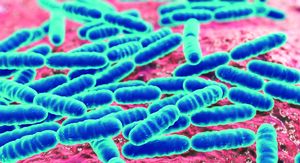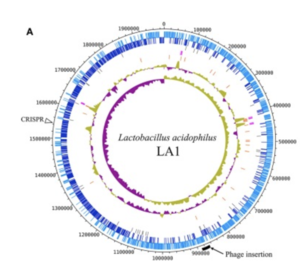Vaginal Microbiota: Canal vs. C-Section: Difference between revisions
| Line 32: | Line 32: | ||
<br> | <br> | ||
====Genome of ''Lactobacillus acidophilus''==== | ====Genome of ''Lactobacillus acidophilus''==== | ||
The complete genome is composed of a 1.99-Mbp circular chromosome with 34.7% G+C content, or the percentage of guanine-cytosine in the RNA (Figure1). The genome of ''Lactobacillus acidophilus'' was sequenced and a total of 1,953 were found in the genome which included 1,844 protein-coding genes, 76 RNA genes, and 33 pseudogenes. There were 4 sets of ribosomal RNA genes which included 5S, 16S, and 23S genes. Additionally, 61 tRNA genes were found as well as three non-coding RNA. | The complete genome is composed of a 1.99-Mbp circular chromosome with 34.7% G+C content, or the percentage of guanine-cytosine in the RNA (Figure1). The genome of ''Lactobacillus acidophilus'' was sequenced and a total of 1,953 were found in the genome which included 1,844 protein-coding genes, 76 RNA genes, and 33 pseudogenes. There were 4 sets of ribosomal RNA genes which included 5S, 16S, and 23S genes. Additionally, 61 tRNA genes were found as well as three non-coding RNA. | ||
<br> | <br> | ||
<br> | <br> | ||
A unique feature of the ''Lactobacillus acidophilus'' is a 26-kbp prophage insertion at the chromosomal position 863,940-890,001. This position and location are similar to other ''Lactobacillus acidophilus'' genes, with the only difference being the number of proteins encoded in that specific region (9). LA1, a strain of ''Lactobacillus acidophilus'', contains the smallest number of genes, and the genes required for insertion include ''attL'', phage integrase, and ''attR'' (9). | A unique feature of the ''Lactobacillus acidophilus'' is a 26-kbp prophage insertion at the chromosomal position 863,940-890,001. This position and location are similar to other ''Lactobacillus acidophilus'' genes, with the only difference being the number of proteins encoded in that specific region (9). LA1, a strain of ''Lactobacillus acidophilus'', contains the smallest number of genes, and the genes required for insertion include ''attL'', phage integrase, and ''attR'' (9). | ||
[[Image:LA Genome.png|thumb|300px|left|Circular map of the Lactobacillus acidophilus LA1 genome. By Chung et al., 2018]] | |||
====Phylogenetic Comparisons==== | ====Phylogenetic Comparisons==== | ||
Revision as of 18:31, 16 April 2022
What is the Vaginal Mirobiota?

By Racine Ross
At right is a sample image insertion. It works for any image uploaded anywhere to MicrobeWiki.
The insertion code consists of:
Double brackets: [[
Filename: PHIL_1181_lores.jpg
Thumbnail status: |thumb|
Pixel size: |300px|
Placement on page: |right|
Legend/credit: Electron micrograph of the Ebola Zaire virus. This was the first photo ever taken of the virus, on 10/13/1976. By Dr. F.A. Murphy, now at U.C. Davis, then at the CDC. Every image requires a link to the source.
Closed double brackets: ]]
Other examples:
Bold
Italic
Subscript: H2O
Superscript: Fe3+
Sample citations: [1]
[2]
A citation code consists of a hyperlinked reference within "ref" begin and end codes.
To repeat the citation for other statements, the reference needs to have a names: "<ref name=aa>"
The repeated citation works like this, with a forward slash.[1]
The vaginal microbiota is known to harbor over 250 species of bacteria such as Actinomyces, Bacteroides, Enterobacter, Mollicutes, Proteobacteria, Salmonella, and Streptococcus (2). In 1892, Albert Döderlein became the first researcher to explain the significance of lactic acid-producing bacteria in the vaginal microbiome (2). Since then, research has evolved to determine the most prominent species found in the vagina, the most common disturbance of the vaginal microbiome, the varying microbiota types, how the microbiota affects childbirth, and so much more. In normal function, the vaginal microbiota contains a mixture and balance of bacteria such as those previously mentioned. Although, comprehensive surveys of the vaginal microbiome have proved that Lactobacillus species are among the dominant vaginal bacterial species in a large proportion of women (3).
Lactobacillus
Lactobacilli are gram-positive, rod-shaped, non-spore-forming bacteria that grow well in microaerophilic conditions (4). As a gram-positive firmicute, Lactobacilli have a thick cell wall with a cell envelope consisting of glycosyl chains, an s-layer, peptidoglycan with teichoic acids, and a cell membrane containing membrane specific proteins.
Genome of Lactobacillus acidophilus
The complete genome is composed of a 1.99-Mbp circular chromosome with 34.7% G+C content, or the percentage of guanine-cytosine in the RNA (Figure1). The genome of Lactobacillus acidophilus was sequenced and a total of 1,953 were found in the genome which included 1,844 protein-coding genes, 76 RNA genes, and 33 pseudogenes. There were 4 sets of ribosomal RNA genes which included 5S, 16S, and 23S genes. Additionally, 61 tRNA genes were found as well as three non-coding RNA.
A unique feature of the Lactobacillus acidophilus is a 26-kbp prophage insertion at the chromosomal position 863,940-890,001. This position and location are similar to other Lactobacillus acidophilus genes, with the only difference being the number of proteins encoded in that specific region (9). LA1, a strain of Lactobacillus acidophilus, contains the smallest number of genes, and the genes required for insertion include attL, phage integrase, and attR (9).
Phylogenetic Comparisons
Energy Source
Include some current research, with at least one figure showing data.
Environmental Interactions
Include some current research, with at least one figure showing data.
Issues with an imbalance of bacteria
Bacterial Vaginosis
Vulvovaginal Candiadiasis
Difference in outcomes between Canal and C-section
Conclusion
References
Authored for BIOL 238 Microbiology, taught by Joan Slonczewski, 2022, Kenyon College

